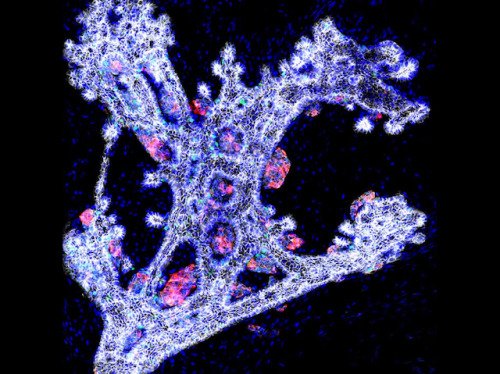
Budding Development
Responsible for producing both pancreatic juices for digestion and hormones regulating blood glucose levels, the pancreas develops from buds of the foregut into a complex multifunctional structure. Pancreatic progenitor cells become either the pancreatic ducts, transporting the pancreatic juices, or the hormone-producing endocrine system, including beta cells synthesising insulin. Guiding cells to either of these fates requires molecules from the Notch signalling pathway, along with a protein called YAP1. In this pancreatic bud, blocking YAP1 leads to more endocrine cells developing, so producing more hormones (in red). Yet pancreatic development is still more complicated, as YAP1 and Notch activity depends on contacts between the pancreatic cells and different proteins in the surrounding extracellular matrix. For researchers working on type I diabetes, an auto-immune disease targeting beta cells, understanding pancreatic development is especially relevant, ultimately helping to better generate endocrine cells in the laboratory, for future replacement therapies.
Written by Emmanuelle Briolat
- Image from Novo Nordisk Foundation Center for Stem Cell Biology (DanStem)
- Novo Nordisk Foundation Center for Stem Cell Biology (DanStem), University of Copenhagen, Copenhagen, Denmark
- Image copyright held by the original authors
- Research published in Nature, November 2018
You can also follow BPoD on Instagram, Twitter and Facebook
Archive link



Комментариев нет:
Отправить комментарий